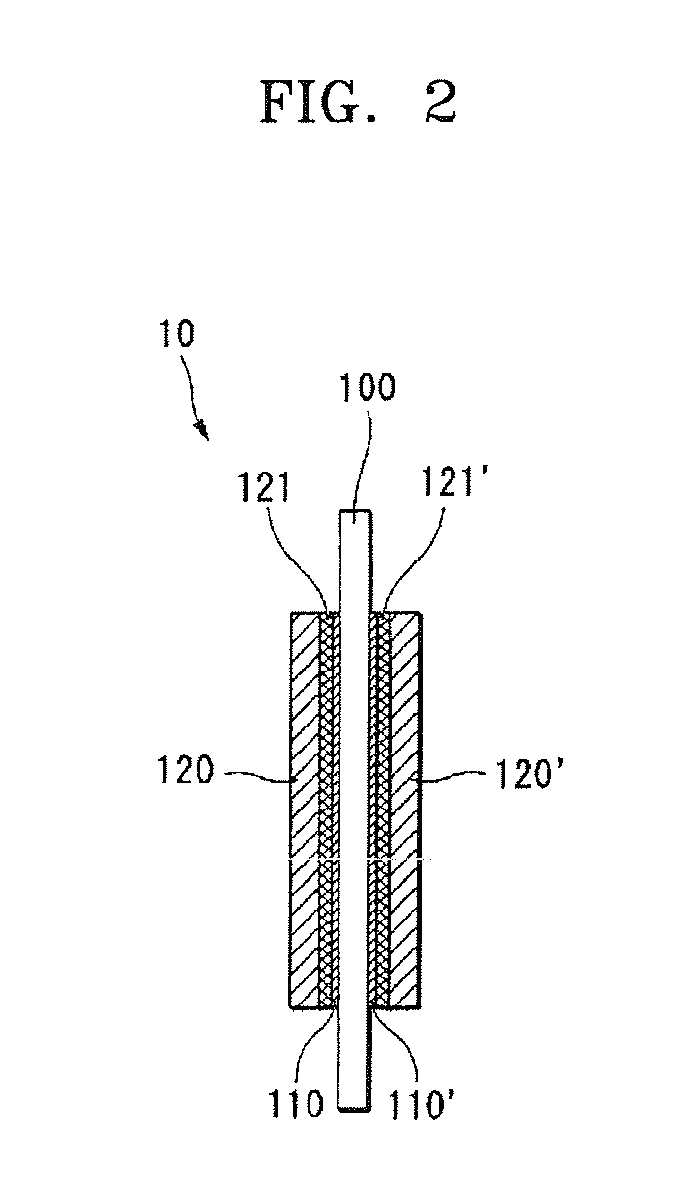Polymer electrolyte membrane for fuel cell, method of manufacturing the same, and fuel cell employing the same
a technology of polymer electrolyte and fuel cell, which is applied in the direction of sustainable manufacturing/processing, final product manufacturing, electrochemical generators, etc., can solve the problems of inability to maintain stable performance for a long time, high probability of fine cracking or fracture, and undesirable effects of electrolyte membran
- Summary
- Abstract
- Description
- Claims
- Application Information
AI Technical Summary
Benefits of technology
Problems solved by technology
Method used
Image
Examples
example 1
[0079]Electrolyte membranes in which a polybenzimidazole crosslinked by 1,4-butanediol diglycidyl ether used as a crosslinking agent was impregnated with 400 wt % of an orthophosphoric acid were manufactured as follows: 5 parts by weight of 1,4-butanediol diglycidyl ether were added to a solution of 10 wt % of poly-2,2′-(m-phenylene)-5,5′-bibenzimidazole represented by (a) of Formula 1 above in N,N-diacetamide to obtain a mixed solution. The mixed solution was cast onto glass substrates and heated at 150° C. for five hours to remove the organic solvent and to induce a crosslinking reaction. As a result, polymer membranes were obtained. The polymer membranes were impregnated with an orthophosphoric acid having a purity of 85 wt % at room temperature for one hour to thereby manufacture electrolyte membranes.
[0080]The dimensional change of the electrolyte membranes was 4% as measured. Durability tests of the electrolyte membranes were also performed. The endurance time of the electroly...
example 2
[0081]Electrolyte membranes in which a polybenzimidazole crosslinked by 1,4-butanediol diglycidyl ether used as a crosslinking agent was impregnated with 120 wt % of an ethylphosphonic acid were manufactured as follows: 10 parts by weight of 1,4-butanediol diglycidyl ether were added to a solution of 10 wt % of poly-2,2′-(m-phenylene)-5,5′-bibenzimidazole represented by (a) of Formula 1 above in N,N-diacetamide to obtain a mixed solution. The mixed solution was cast onto glass substrates and heated at 150° C. for five hours to remove the organic solvent and to induce a crosslinking reaction. As a result, polymer membranes were obtained. The polymer membranes were impregnated with an ethylphosphonic acid having a purity of 85 wt % and that had been heated at 120° C., for five hours to thereby manufacture electrolyte membranes.
[0082]The dimensional change of the electrolyte membranes was 0% as measured. Durability tests of the electrolyte membranes were also performed. The endurance t...
example 3
[0083]Electrolyte membranes in which a polybenzimidazole was impregnated with 210 wt % of a vinylphosphonic acid were manufactured as follows: A polybenzimidazole represented by (e) of Formula 2 below was dissolved in N,N-diacetamide to obtain a polymer solution containing 10 wt % of the polybenzimidazole. The polymer solution was cast onto glass substrates and heated at 150° C. for five hours to remove the organic solvent. As a result, polymer membranes were obtained.
[0084]wherein n is 340.
[0085]The polymer membranes were impregnated with a vinylphosphonic acid having a purity of 85 wt % and that had been heated at 120° C., for one hour to thereby manufacture electrolyte membranes.
[0086]The dimensional change of the electrolyte membranes were 2% as measured. Durability tests of the electrolyte membranes were also performed. The endurance time of the electrolyte membranes was 800 hours.
PUM
| Property | Measurement | Unit |
|---|---|---|
| Temperature | aaaaa | aaaaa |
| Fraction | aaaaa | aaaaa |
Abstract
Description
Claims
Application Information
 Login to View More
Login to View More - R&D
- Intellectual Property
- Life Sciences
- Materials
- Tech Scout
- Unparalleled Data Quality
- Higher Quality Content
- 60% Fewer Hallucinations
Browse by: Latest US Patents, China's latest patents, Technical Efficacy Thesaurus, Application Domain, Technology Topic, Popular Technical Reports.
© 2025 PatSnap. All rights reserved.Legal|Privacy policy|Modern Slavery Act Transparency Statement|Sitemap|About US| Contact US: help@patsnap.com



